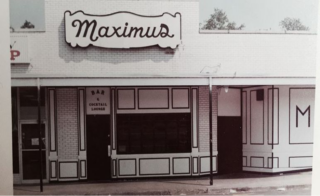
200 South Main Street in New City may be home to a library express now, but in the mid-70s and 80s, the venue was anything but quiet. The unassuming site once served as home for Maximus, Rockland County’s most popular dance club for 18 to 21-year-olds from 1974 to 1986. Labeled by regulars as “comparable to Studio 54” in New York City, the venue had also been a club in the early 1970s—then called The Marshmallow and owned by ’69 Mets players Art Shamsky and Phil Linz. A reputation for fights and generally chaotic atmosphere forced operations to shut down in 1973. The club would have stayed closed for good, had Brooklynite construction worker Bob Diamond not stepped in.
“It so happens that my uncle was the accountant for The Marshmallow,” said Brad Diamond, son of Maximus owner Bob Diamond. “He turned to him and said, ‘Hey, this place actually does make money, but you’re going to have to really be there and sit on the business. Are you interested?’”
Though the elder, then 34-year-old Diamond had no prior business experience, not to mention a wife and two children to feed, he decided his answer was ‘yes.’ After purchasing the club and deciding on its new moniker—Maximus was chosen in no small part due to the letter “M” already accenting many of the venue’s walls—Diamond worked hard over the next year to procure a New York liquor license and prepare the club for opening. He also sat down with the Clarkstown Police Department to establish his commitment to crowd control. The only task left on opening night was for a crowd to show.
“Of course my family (at home) was very nervous,” said Brad, referring to Maximus’ opening night in June of 1974. “The night went on and finally my father called home. My mother answered the phone and said, ‘How’s it going? We’re all nervous!’ He said, ‘There’s a line out the door and around the shopping center!’”
The Rise of Maximus
From that point on, Maximus’ reputation as the hot spot for young people in Rockland and surrounding counties skyrocketed. The seven days-a-week, 365 days-a-year club boasted three bars for the hundreds of clubgoers, the main of which was fifty feet long and taken from the 1964 World’s Fair in Queens, another which bore the name Harry’s to honor Bob’s father-in-law, who worked as a clicker for a time. A sprawling dance floor took up much of the downstairs area, with lifeguard chairs on both ends for security to keep an eye on dancers. Music—mostly rock at the time—was selected from a record library of thousands; Billboard Music called Maximus DJs often to help determine what songs would be in their Top 100 for the week. Screens were installed in the 80s, allowing clubbers to dance along to hit music videos of the time.
Through it all, Bob Diamond was there. For the first seven years of Maximus’ lifespan, the newly minted business owner was at the club every night, overseeing everything from drink totals to crowd control. A boy at the time, Brad remembers his father beginning his hour-and-ten-minute commute from their home in Long Island at 4 p.m. each day, often pulling into the driveway at 6 in the morning.
“My father was such a hard worker,” Brad recalled. “It wasn’t an easy commute. He could have moved up to Rockland County, but he was thinking of his family. He was afraid that if there was a problem at the bar and they had to throw somebody out, we wouldn’t be (safe)—so he decided living away would be better.”
The Maximus Family
Maximus’ resounding success would not have been possible, Brad iterated to RCT, without the dozens of young people who made up its staff of waitresses, bartenders, and security. The majority of employees were college students, working on nights and weekends to pay their way through school. According to Joe Carelli, a former bartender who worked himself up to becoming a partner of the business, this hiring practice was intentional.
“College kids have something to lose,” Carelli explained. “When you’d get these athletes and they’re going to school, they have careers that are coming up. They don’t want to get into bar fights and hurt somebody, then lose their whole career because they went to jail or whatever…When somebody got out of hand, we’d just get them out the door.”
Decades later, Carelli and several other former employees remain proud of the family they built while working at Maximus. From egging each other on in drink-selling competitions to scarfing down pizza while decorating for special events, many in the now 60-something-year-old crowd remember their time at the club with great fondness, regularly sharing memories of the “good old days” among themselves and former customers through the 1,694 member Facebook group Maximus Memories. Though Bob has preferred to stay out of the limelight since Maximus’ closure in 1986, the legacy he left behind will surely be remembered for years to come.
“It was an awesome time in my life—an awesome time to live,” Carelli recalled, smiling. “It was absolutely exciting. We looked out for each other, we cared about each other. And all of us became a family.”


You must be logged in to post a comment Login